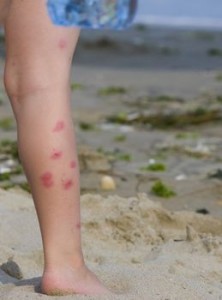Beware of Sand Flea and Sand Fly
Outdoor holiday at the sandy beaches or jungle trekking in the woods can be fun and enjoyable for the family but not when you are ill-prepared to avoid long lasting scars and wound on the skin due to bites by blood sucking sand fleas and sand flies.
How Sand Flea & Sand Fly bites affect your skin and health?
Their bites may leave large, red itchy bumps that may turn into a rash.
These bumps are frequently several times as itchy as mosquito bites, and tend to last longer as well.
They leave permanent scars on your skin. You might have sleepless night due to itch at those bite areas.
Scratching leads to more scratching that simply escalate the problem.
Sand fleas are more tenacious than sand flies. They are like parasites, attach themselves to their human host, piercing into the skin and feeds off the blood of the host.
Sand fleas have a tendency to follow the host such as human and pet when they return home after beach vacation.
Removing them from your home can be tedious.
Sand flea bites are also known to carry various diseases such as Carrion’s disease, the Pappataci fever virus, and various parasites that can cause conditions such as Leishmaniasis.
Leishmaniasis is not as widely known as malaria, but is just as painful and dangerous.
Because the sand flea feeds on human blood, there is the possibility of transferring protozoan parasites that are responsible for this disease to humans.
Click to read more: Facts about Sand Flea and Sand Fly
Related posts: 5 things you should do to avoid being bitten by sand flea & sand fly




Comments 1 Comment